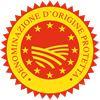Description
Pecorino di Filiano PDO is a hard cheese produced with whole sheep’s milk from animals belonging to Gentile di Puglia, Gentile di Lucania, Leccese, Comisana, Sarda breeds and their cross-breeds.
Production Area
The production area of Pecorino di Filiano PDO is within the territory of 30 municipalities in the Province of Potenza, in the Basilicata region.
Production Method
The milk must come from one or two milkings drawn from animals that are pasture-grazed or fed with fresh fodder and hay from the terroir of origin. It must be processed within 24 hours of the first milking. The raw milk is filtered and heated traditionally in tin copper boilers until it reaches 40 °C. Curdling takes place at 36-40 °C, with the addition of kid or lamb rennet paste. The curd is broken into grains the size of a rice grain, after which it is extracted and inserted into reed moulds; the moulds can be made of other suitable materials. While the cheese is taking its shape, the curd is manipulated by hand in order to stimulate the expulsion of the whey. After dry salting or brining, the wheels are ripened for at least 180 days, in characteristic tufa caves or other suitable environments; from the twentieth day of ripening, the rind of the cheese may be brushed with extra virgin olive oil, produced in Basilicata, and wine vinegar.
Appearance and Flavour
Pecorino di Filiano PDO has a cylindrical shape with flat surfaces, a diameter of 15 to 30 cm and a heel of 8 to 18 cm; its weight varies from 2.5 to 5 kg. The rind is characterised by the marks left by the basket in which it was shaped; it is golden yellow to dark brown, depending on the length of the ripening period. The cheese is grainy and crumbly and has a white to straw-yellow colour. It has a firm consistency, with small eyes randomly scattered throughout. The fresh cheese has a sweet and delicate flavour, becoming slightly piquant when the minimum level of ripening has been reached. The aroma is reminiscent of sheep’s milk, with hints of grass and, in the very mature variety, roasted hazelnuts.
History
The importance of sheep breeding in the production area dates back to at least the Roman conquest of this region, if not earlier, when the shepherds produced sheep’s cheese during the migration of the flocks. The expansion of dairy production continued into the Sveva and Angioina Age, increasing further in the 16th-17th centuries with the Doria, the feudal lords of the Vulture area, who organised production facilities by establishing specialised manor farms for rearing sheep. In the Municipality of Filiano, from where the cheese takes its name, there has been an annual festival for 41 years, evoking history and tradition and valorising the product.
Gastronomy
Pecorino di Filiano PDO should be kept in cool, dry places or, if in pieces, in the least cold compartment of the refrigerator. This product is an excellent table cheese. Due to its decisive flavour it naturally pairs with many strong-flavoured dishes, typical of Lucana cuisine, especially grated on fresh pasta with meat sauce.
Marketing
The product is marketed as Pecorino di Filiano PDO. It is sold year-round, whole or in pieces, either half or quarter of the certified wheel. It must bear the fire-branded product logo.
Distinctive Features
Pecorino di Filiano PDO is still produced using traditional tools, for example the wooden cane with a bulbous end, known as a scuopolo or ruotolo, which is used to break the curd.



















![[VIDEO] Pecorino di Filiano DOP, produzione in lieve calo e ora si punta sulla formazione](https://www.qualivita.it/wp-content/uploads/2024/09/TGR-Basilicata_Pecorino-Filiano-DOP-210x118.jpg)



